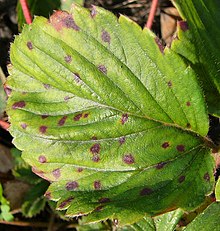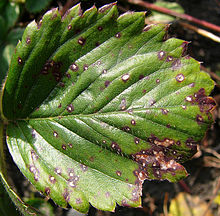Mycosphaerella fragariae
| Common spot of strawberry | |
|---|---|

Younger stadium of Mycosphaerella fragariae on strawberry
|
|
| Common names | Common leaf spot, leaf blight of strawberry |
| Causal agents | Mycosphaerella fragariae |
| Hosts | Strawberry |
| EPPO code | MYCOFR |
| Mycosphaerella fragariae | |
|---|---|
 |
|
| Older stadium of Mycosphaerella fragariae on strawberry | |
| Scientific classification | |
| Kingdom: | Fungi |
| Division: | Ascomycota |
| Subdivision: | Pezizomycotina |
| Class: | Dothideomycetes |
| Order: | Mycosphaerellales |
| Family: | Mycosphaerellaceae |
| Genus: | Mycosphaerella |
| Species: | M. fragariae |
| Binomial name | |
|
Mycosphaerella fragariae (Tul.) Lindau, 1897 |
|
| Synonyms | |
|
|
Common spot of strawberry is one of the most common and widespread diseases of strawberry. Common spot of strawberry is caused by the fungus Mycosphaerella fragariae (imperfect stage is Ramularia tulasnei). Symptoms of this disease first appear as circular, dark purple spots on the leaf surface. Mycosphaerella fragariae is very host specific and only infects strawberry.
Mycosphaerella fragariae is a species from family Mycosphaerellaceae.
This disease affects strawberry plant foliage causing purple spots ⅛ to ¼ inches across on the upper side of the leaves. At first, the whole spot is purple but as the disease matures the center of the leaf spots become tan or gray, then almost white. When numerous spots merge foliage death can occur; this can stunt or kill infected plants when severe.
On petioles, stolons, calyxes, and fruit trusses, elongated lesions may form and interfere with water transport in the plant, weakening the plant and making it more susceptible to invasion by a secondary organism.
The disease cycle starts when the pathogen overwinters as mycelium or fruiting structures in leaf debris and spores are spread by rain splash infecting new leaves as they emerge in the spring when conditions are favorable. Disease development is most successful in cool daytime temperatures and cold nighttime temperatures, high relative humidity, and wet conditions.
Common spot on strawberry is a polycyclic disease, and under favorable conditions it will continue to reinfect the host and surrounding plants. The fungus overwinters as mycelium, sclerotia, and perithecia in infected leaf tissues. This disease on strawberry can generate two types of spores that infect newly-emerging leaves in the spring, conidia spores and ascospores.
Older infected leaves that remain alive during winter may give rise to conidia that are spread to new foliage by splashing water or human contamination. Another type of spore (ascospore) is generated in speck-sized black perithecia, which are produced at the edges of the leaf spots during autumn. In the spring, these ascospores are ejected from the perithecia and spread by wind or water to infect new leaf tissue. Infected leaves that survive the winter can reinfect. Under favorable conditions, dispersal of this disease will continue by splashing water or machinery.
High rainfall and warm temperatures are most favorable for this pathogen and lead to rapid disease development. During mid to late spring, infections may be most severe due to frequent rain showers. The optimal temperature that will allow for most successful growth of the pathogen and development of disease is around 25°C. The fungal pathogen favors 12 or more hours of leaf wetness for infection. New, young foliage has been found to be more susceptible to the pathogen when compared to mature, developed foliage.
...
Wikipedia
